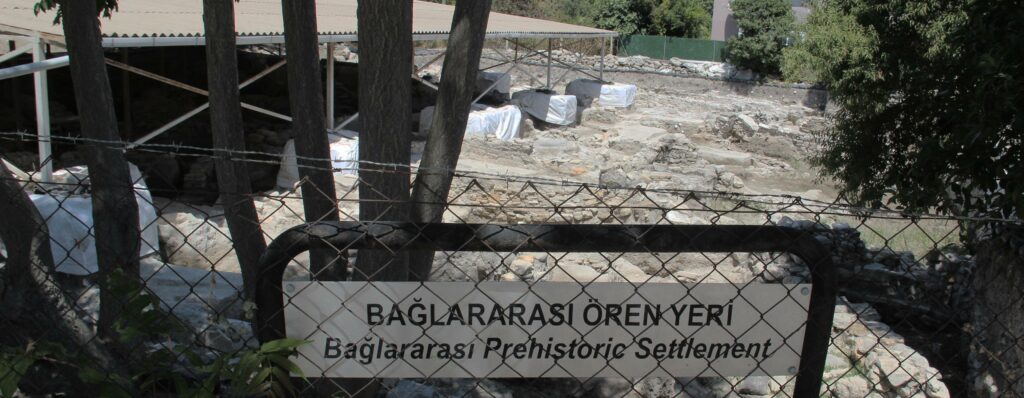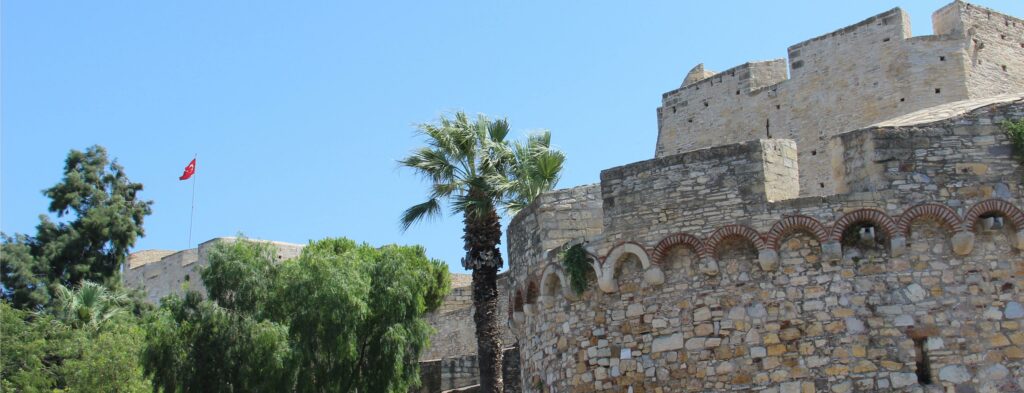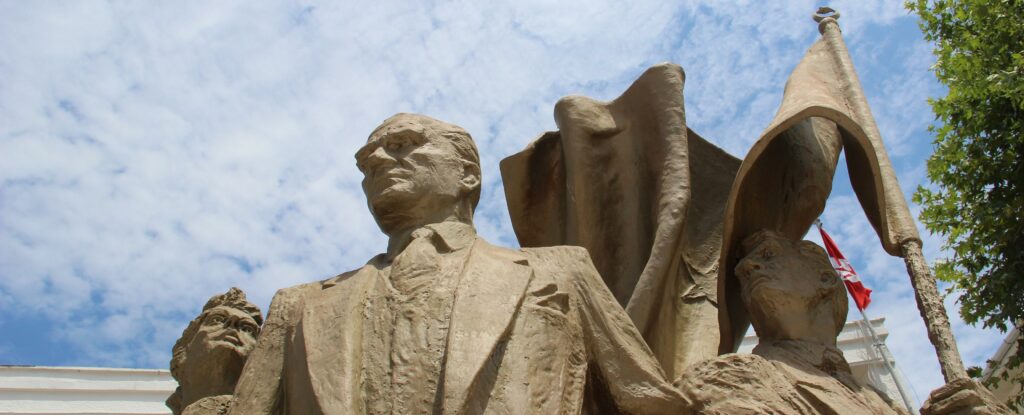Known for its rich history, Çeşme has been a strategic and cultural hub for centuries. Historic Çeşme was an important port city during ancient times, with roots going back to the Ionians, Greeks, and Romans. One of its most prominent landmarks is the historic Çeşme Castle, built by the Ottomans in the 16th century to defend against attacks from the Venetians. The castle now houses a museum showcasing local history and artefacts from the famous Battle of Çeşme (1770), a major naval battle during the Russo-Turkish War.
Historic Çeşme also has remnants of ancient civilisations, with Greek and Roman architectural influences throughout the town. It was historically a gateway between Europe and Asia, thriving with trade and cultural exchanges.
Quick historic Çeşme links:
Historic Çeşme – Table of Contents
A Brief Chronological History of Çeşme
Ancient Çeşme
As evidenced at the archaeological site at Çeşme-Bağlararası, there were bronze age settlements Circa 6000 B.C. Çeşme, historically known as Cyssus, was a prominent settlement in antiquity. Its strategic position on the Aegean coast and proximity to Chios and Ephesus shaped it. Circa 1000 B.C., it was settled by the Ionians, and the town now known as Çeşme was part of the Ionian League, a confederation of twelve cities, including nearby Ephesus and Smyrna (modern İzmir). Circa 6th Century B.C., the Lydian Kingdom dominated the region, conquered by the Persian Empire under Cyrus the Great.
In 334 B.C. Alexander the Great liberated Ionian cities from Persian rule, including Çeşme, leading to a Hellenistic period of prosperity. In the 2nd Century B.C., the region came under the control of the Roman Empire after the defeat of the Seleucid Empire. Between the 4th and 15th Century A.D., as part of the Byzantine Empire, Çeşme remained a coastal outpost, overshadowed by the more significant city of Chios. Byzantine influence persisted, but the region became vulnerable to pirate raids and external invasions, including those by the Seljuks and other Turkic groups.

| c. 6000 BC | Early bronze age site Çeşme-Bağlararası (Sk. 1037) |
| c. 1000 BC | Ionian settlement |
| c. 800BC | Homer was born in Ionia (Smyrna, Colophon or Chios) |
| 610 BC | Lydian rule – Çeşme is known as Cyssus (Κύσσος) |
| 545 BC | Persian rule – Cyrus the Great, destruction of Smyrna |
| c. 700 BC 453 BC 412 BC | Erythrai Ionian city, member of the Pan-Ionian League Erythrai leaves the Delian League Erythrai Revolt from Chios -Peloponnesian War |
| 334 BC | Ionian independence under Alexander the Great |
| 323 – 190 BC | The region is part of the Hellenistic Seleucid Empire |
| 190 – 133 BC | Treaty of Apamea transfers region to the Kingdom of Pergamon |
| 133 BC | Roman rule – Kingdom of Pergamon bequeathed to Rome |
| 395-1371 | Greek Byzantine rule – Çeşme is known as Kyssos/Kysos |
| 1081-1097 | Admiral Çakabey temporarily captures Izmir, Çeşme & Chios Izmir principality established, then returned to Byzantine |
| 1204-1261 | Greek Byzantine Nicene Empire |
| 1304-1566 | Genoese rule in Chois |
| 1371 | Aydınoğlu Umur Bey recaptures Chios, Çeşme & Izmir |
see also
- Details of the archaeological site at Çeşme-Bağlararası
- Details of the archaeological site at Erythrai
- The legendary ancient Greek poet Homer
Ottoman Çeşme
Çeşme was a key harbour both in the rise and decline of the Ottoman Empire from the early exploits of Admiral Çakabey in the C11th through to the destruction of the Ottoman fleet by the Russians at the Battle of Chesme. Çeşme flourished under Ottoman rule as a key naval and trade hub. Its prominence grew with its strategic role in maritime affairs, particularly in the Aegean. In 1415, the Ottomans, led by Sultan Mehmed I, incorporated Çeşme into the empire during the early conquests of western Anatolia.
In the 16th Century, Çeşme became an essential port for trade and naval activities. The Ottomans invested in infrastructure, including Çeşme Castle, built by Sultan Bayezid II in 1508 to defend the coastline against pirate and Venetian attacks. In 1770, the Battle of Çeşme occurred between the Ottoman and Russian navies during the Russo-Turkish War. The Russian fleet, under Admiral Alexei Orlov, decimated the Ottoman fleet in Çeşme Bay.
This battle was a significant defeat for the Ottoman Empire and left a lasting mark on the region’s history. During the 18th and 19th Centuries, Çeşme remained a prosperous town, benefiting from trade with the Aegean islands, particularly Chios. It became known for its agriculture, mainly olives and figs, and the mastic trade shared with Chios.

| 1371 | Aydınoğlu Umur Bey recaptures Chios, Çeşme & Izmir |
| Circa 1415 | The town is named Çeşme |
| 1472 & 1501 | Çeşme attacked by Ven |
| 1508 | Sultan Beyazit II (1447-1512, Sultan from 1481) Construction of Çeşme Castle |
| 1528 | Süleyman the Magnificent (1494-1566, Sultan from 1520) Construction of Çeşme Caravanserai |
| 1566 | Grand Admiral Piyale Pasha (1515-1578) Chios capture ends Genoese presence in the Aegean |
| 5–7 July 1770 | Grand Admiral Cezayirli Gazi Hasan Pasha (1713-1790) Battle of Chesme |
| 1780 | İlyaszade fountain (Sk. 2032) earliest existing fountain |
| Mar-Apr 1822 | Greek rebellion in Chios & Ottoman reprisal |
| 1832 | Ayios Haralambos Church (Ataturk Blvd.) |
| 1835 | Osman Ağa Mosque (Sk. 1015) |
| 1842 | Hacı Mehmet Ağa Mosque (Sk. 1013) |
Historic Çeşme see also:
Turkish Republic Çeşme
During the Greco-Turkish War, it was among the final towns liberated, with the last Greek troops evacuating to Chios on 16th September 1922. Following the establishment of the Republic of Turkey, Çeşme transitioned from a small trade town to a major tourist destination known for its beaches, thermal springs, and historical sites. After the Treaty of Lausanne in 1923, Çeşme experienced a significant demographic shift due to the population exchange between Greece and Turkey. Greek Orthodox residents left for Greece, and Muslim Turks from Greece (particularly Crete) settled in Çeşme, altering its cultural makeup.
From the 1950s through the 1970s, Çeşme grew as a regional agricultural and fishing hub, and its prominence as a tourist destination began in this period, as its beaches and thermal spas attracted visitors from İzmir and other parts of Turkey. From the 1980s through the 2000s, Çeşme’s transformation into a luxury resort town accelerated, with investments in infrastructure, marinas, boutique hotels, and restaurants. Alaçatı, a nearby village within Çeşme’s district, became a hotspot for windsurfing, upscale tourism, and cultural festivals.
Since then, Çeşme has solidified its reputation as a premier Turkish vacation destination. Its marina, historical sites like Çeşme Castle, and frequent festivals attract Turkish and international visitors. It is also celebrated for its Aegean cuisine and connection to the Greek island of Chios and the Greek Islands.

| 1912 | Balkan Wars Turkish refugees settle in Çiftlikköy |
| 30 May 1913 | Treaty of London cedes Chios to newly independent Greece |
| 1919-1922 15 May 1919 13-22 Sept 1922 16 Sept 1922 | Greco-Turkish War / Turkish War of Independence Greece captures Çeşme & Alaçatı The Great Fahrettin Altay liberates Çeşme |
| 23 July 1923 | Treaty of Lausanne, Greece/Turkey population exchange |
| 1923-1938 30 June 1926 1-8 July 1926 Nov 1937 | First president Mustafa Kemal Atatürk (1881-1938) Atatürk, İ. İnönü & F. Altay dinner at Rasim Palace, Ilica, Çeşme Atatürk stays one week in Ilica, Çeşme Atatürk second visit to Çeşme on the yacht Lilias |
| 1938-1950 | Second president Mustafa İsmet İnönü (1884-1973) born Smyrna |
| 1939-1945 1941-1944 | World War II – Turkey remains “neutral” Chios is occupied by Nazi Germany |
| 23 July 1949 | Karaburun–Chios earthquake |
| 1980s | Agriculture starts to transition away from tobacco crops |
| 1990s | Sharp rise in tourism infrastucture |
| 1996 | İzmir-Çeşme Motorway (Otoyol 32) completed |
| 2001 | Sheraton Çeşme (now Swissôtel) opens in Ilıca |
| 2010 | Çeşme Marina opens |
| 2012 | Naval Martyrs’ Monument returned to Çeşme |
| 2023 | Çeşme City Memory Museum opens |
| 2024 | Arkas Sanat Art Gallery in Alaçatı |
Other Historic Çeşme Links
Çeşme Municipality – City Guide (English Website)
